(Wet)Suiting up for research
by Paul Richardson (VIMS lab technician)
The Experimental Site
Just barely over my jet lag, we recently set up the main ZEN experiment at the Fårö Island eelgrass meadow in about 3 -4 meters of water a one hour boat ride from the field station in Korpoström. Unlike the warm shallow waters of the Virginia grass beds, all of the work was done in SCUBA with dry suits by Camilla, Anna and Christoffer. I assisted from the boat or in my 7mm wetsuit with snorkel gear.
The plots were staked out with short galvanized rebar rods instead of the PVC poles that make up our “pole gardens” in Virginia. For marking tags they ingeniously employed cut squares of linoleum flooring tabs. The site perimeter is marked by small buoys. Because the water is so deep at the field site, there is no worrying that a small boat will run over the plots.
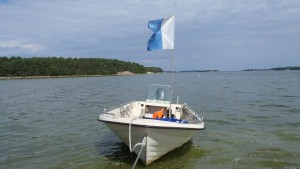
The research vessel used by the ZEN team in Finland. Note the blue and white dive flag. In the U.S.A., red and white flags are used to alert that divers in the water.
Witnessing the huge addition of logistical effort to conduct the ZEN work in deeper water with SCUBA and especially dry suits gives me a new appreciation for what the ZEN partners working at deeper subtidal sites have to do to get the job done. Everything takes at least twice as long. The work and general communication is more difficult. Work is limited by the air in the tanks, bottom time, and general fatigue. Once the work is done and everyone is out of their dry suits, they can’t just jump back in the water and fix something if needed. It usually takes another planned trip.
Algal Blooms!
Further complicating matters is the fact that the usually clear waters of the field site (see pictures from the 2011 experiment) have been clouded by a senescing blue green algae bloom that leaves the water full of chunks of a green, snot-like substance that you don’t want to swallow – apparently it is hazardous to your health. Also, the eelgrass beds are covered with a matrix of algae that are dominated by the frilly Ectocarpus. Otherwise, the eelgrass blades themselves are beautiful, green and covered with very few epiphytes. But these Ectocarpus mats are so thick that in places they go completely anoxic and turn white. We see similar effects during certain times of the year in Virginia where large blooms of the green algae Ulva and red Gracilaria drift in and smother the eelgrass in the Chesapeake. Here in Finland there is the danger that if you disturb these mats you can get a shot of hydrogen sulfide that can penetrate right through your skin.
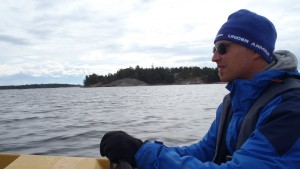
Christoffer Boström navigates the complicated seascape of the Archipelago Sea to the ZEN project site on Fårö Island, Finland.
Also, since the Fårö Island site is about 24 km away it requires an hour long boat ride. With fuel costing 1.63E/L (that’s $6,71/gal) and SCUBA setup and breakdown time, every field trip is a significantly greater investment of time and money than what I’m used to. Field days are usually 15 hour days. But once it’s all done I know it will all have been worth it.
According to the locals and everything that I’ve read, the Archipelago Sea has over 30000 islands! Being the experienced boat captain that I am back in the States, I can say that I won’t even attempt to navigate a boat around here. The gauntlet of islands on the way to the field site is mind boggling. I’ll leave the navigating and boat driving to Camilla, Marie, and Christoffer, who have the local knowledge and skills to safely transport us to and from the field site at Fårö Island.
Finnish News Media!
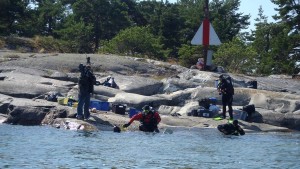
Journalists from the Finnish Nature channel film the ZEN team in Finland as they prepare to setup a large experiment
On top of everything else, we also had a visit from the Finnish news media. Christoffer brought them by boat to our remote field site shortly after the beginning of the work on the 13th. We were each interviewed for the national T.V. news, the radio, and the magazine, Suomen Luonto, which literally translated, means “Finnish Nature.”
It went pretty well, except that I gave the reporter some footage of us working in the grass beds of Virginia and I neglected to delete the audio which I didn’t think would be included, but it was. Also, in my jetlagged state, I mentioned that prior to the human perturbations in the Chesapeake Bay, “there was 90 % more (sea) grass in the Bay,” which, if taken out of context is not exactly correct. The seagrass coverage that we have now is 10% of historic levels. In other words, seagrass coverage in the Bay was historically 900% of current levels! Either way you look at it, that’s a huge and worrisome decline given all the important ecosystem services and functions that seagrasses provide. Media exposure can be good for your cause, but I’m finding it can also be difficult. Anyhow, overall, I think we got the message across that eelgrass meadows are important systems all over the northern hemisphere and that they need to be protected. Check out the ZENscience news page for a link to this story.


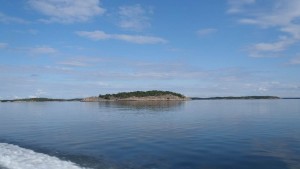
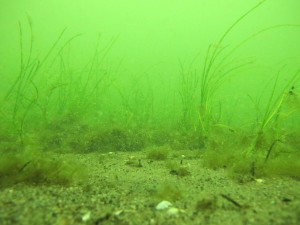
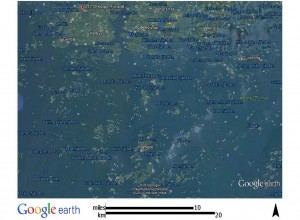

Comments are closed.